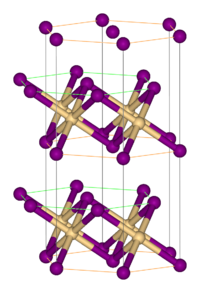Cobalt(II) bromide
 |
|
| Identifiers | |
|---|---|
|
3D model (Jmol)
|
|
| ChemSpider | |
| ECHA InfoCard | 100.029.242 |
|
PubChem CID
|
|
| RTECS number | GF9595000 |
|
|
|
|
| Properties | |
| CoBr2, CoBr2.6H2O, CoBr2.2H2O | |
| Molar mass | 218.7412 g/mol (anhydrous) 326.74 g/mol (hexahydrate) |
| Appearance | Bright green crystals (anhydrous) Red-purple crystals (hexahydrate) |
| Density | 4.909 g/cm3 (anhydrous) 2.46 g/cm3 (hexahydrate) |
| Melting point | 678 °C (1,252 °F; 951 K) (anhydrous) 47 °C (hexahydrate) |
|
anhydrous: 66.7 g/100 mL (59 °C) 68.1 g/100 mL (97 °C) hexahydrate: 113.2 g/100 mL (20 °C) |
|
| Solubility | 77.1 g/100 mL (ethanol, 20 °C) 58.6 g/100 mL (methanol, 30 °C) soluble in methyl acetate, ether, alcohol, acetone |
| +13000·10−6 cm3/mol | |
| Structure | |
| Rhombohedral, hP3, SpaceGroup = P-3m1, No. 164 | |
| octahedral | |
| Hazards | |
| Safety data sheet | Fisher Scientific |
| R-phrases (outdated) | R36, R37, R38 |
| S-phrases (outdated) | S26, S37, S39, S45, S28A |
| NFPA 704 | |
| Flash point | Non-flammable |
| Lethal dose or concentration (LD, LC): | |
|
LD50 (median dose)
|
406 mg/kg (oral, rat) |
| Related compounds | |
|
Other anions
|
cobalt(II) fluoride cobalt(II) chloride cobalt(II) iodide |
|
Other cations
|
iron(II) bromide nickel(II) bromide |
|
Except where otherwise noted, data are given for materials in their standard state (at 25 °C [77 °F], 100 kPa).
|
|
|
|
|
| Infobox references | |
Cobalt(II) bromide (CoBr2) is an inorganic compound. It is a red solid that is soluble in water, used primarily as a catalyst in some processes.
When anhydrous, cobalt(II) bromide appears as green crystals. The hexahydrate loses four waters of crystallization molecules at 100 °C forming the dihydrate:
Further heating to 130 °C produces the anhydrous form:
The anhydrous form melts at 678 °C. At higher temperatures, cobalt(II) bromide reacts with oxygen, forming cobalt(II,III) oxide and bromine vapor.
Cobalt(II) bromide can be prepared as a hydrate by the reaction of cobalt hydroxide with hydrobromic acid:
Anhydrous cobalt(II) bromide may be prepared through the direct reaction of elemental cobalt and liquid bromine.
The classical coordination compound bromopentaamminecobalt(III) bromide is prepared by oxidation of a solution of cobalt(II) bromide in aqueous ammonia.
Triphenylphosphine complexes of cobalt(II) bromide have been used as a catalysts in organic synthesis.
Exposure to large amounts of cobalt(II) can cause cobalt poisoning. Bromide is also mildly toxic.
...
Wikipedia

